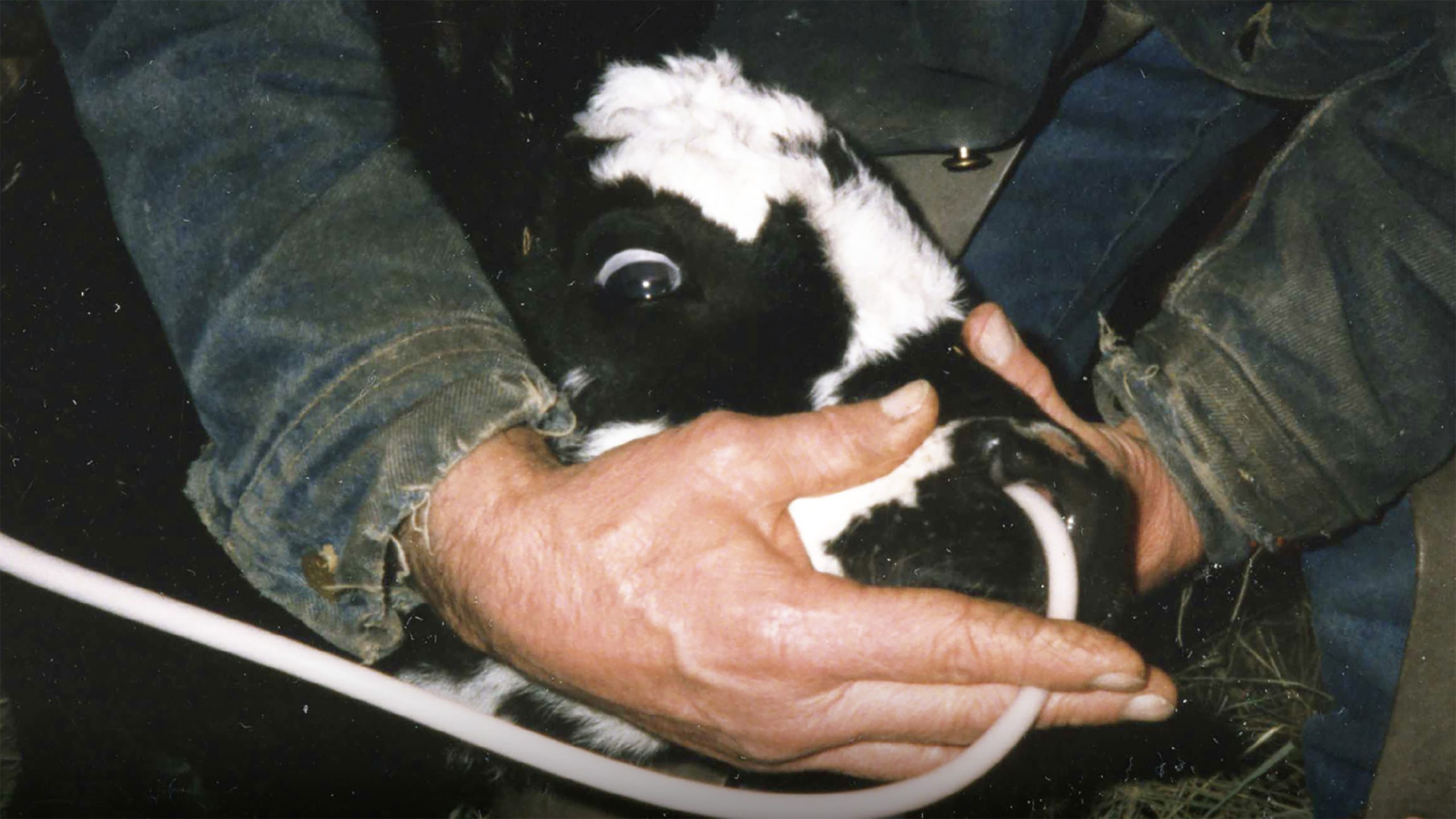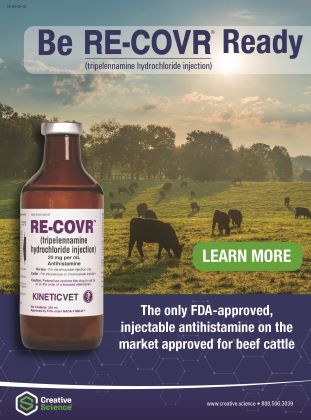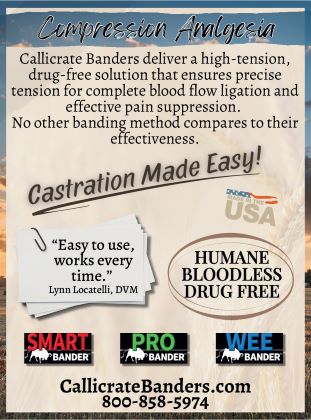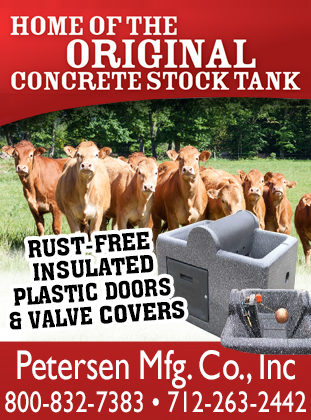Tips on Using an Esophageal Feeder and a Nasogastric Tube

Tips on Using an Esophageal Feeder and a Nasogastric Tube
By Heather Smith Thomas
Sometimes it is necessary to get fluid into a calf that can’t suckle. It might be a newborn that needs colostrum but is compromised from a hard birth and unable to suckle a bottle, or it might be a sick, dehydrated calf that needs fluid but is not yet to the point of needing an IV, and you can administer fluids and electrolytes orally.
If a newborn is unable to suckle, the quickest and safest way to get colostrum into him is by tube. A sick calf generally won’t suck a bottle, and the only way to give him oral fluid is by tube.
There are two ways to “tube” a calf—and two types of tubes for administering oral fluid. You can use an esophageal feeding probe (a metal or plastic tube that goes down the calf’s throat and partway down the esophagus—about 16 inches–attached to a container that holds the fluid, or you can use a smaller diameter flexible nasogastric tube that goes into the nostril and down into the stomach.
Years ago, before esophageal feeders were invented, a nasogastric tube was the only way to get fluid into a calf. Our veterinarian showed us how to use the “nose tube” in 1969 when we were treating some calves for scours. Since then, we’ve “tubed” hundreds of calves. This handy tool made it easy to give fluids/electrolytes and oral medications to sick calves, revolutionizing our ability to prevent dehydration and treat serious illness. We still use a nasogastric tube; in some instances it’s more effective than the shorter esophageal probe. We also use a larger diameter nasogastric tube for administering fluid (or mineral oil) to adult cattle.
For giving baby calves colostrum or electrolyte fluids, however, the esophageal probe feeder is adequate, and easy to use. Many people today use this handy tool. When the calf is properly restrained and the probe carefully placed, it is an effective and safe way to give fluid. Both types of tube must be inserted carefully and properly, to decrease risk of injuring or drowning the calf.
If you ever need to administer mineral oil to a calf, always use a tube (either an esophageal feeder tube or nasogastric tube) rather than trying to “drench” the calf. You don’t want to risk having any oil get into the windpipe. If even a drop or two get down into the lungs, the calf will get aspiration pneumonia, since the oil can’t be worked out/coughed out of the lungs like a little water can.
Esophageal Feeder
The feeder probes are nonflexible plastic or stainless steel tubes (about ½ inch in diameter) with larger bulb on the end that goes down the throat. A container for milk or fluid is attached to the other end. Some have a valve that keeps the fluid in the container until you release it. Others have a bag that hangs down until you have the probe in place in the calf’s esophagus and are ready to administer the fluid; then you raise the bag up to send fluid into the tube.
The rounded bulb on the end of the probe protects the mouth and throat from being scraped or punctured and helps prevent backflow of fluids up the esophagus, acting as a plug. It also helps the tube bypass the larynx and small opening into the windpipe when inserting the tube into the throat. The windpipe is slightly below and alongside the opening into the esophagus. You must not get any fluid into the windpipe.
Make sure the feeding probe/container is clean; wash it thoroughly after each use. When administering colostrum or fluid, make sure it is body temperature for the calf—not too warm or cold.
If the calf is lying down, lift his head up to insert the tube. If he struggles, lift his front end up so he’s sitting on his haunches; you can restrain him more easily that way while you lift his head to insert the tube. If he’s standing, back him into a corner (or have someone hold his back end), step over his back so you can hold his head and neck between your legs, and pull his head up with one hand under the lower jaw—so you can insert the tube with your other hand.
If it’s a cold day, warm the tube in hot water before you insert it. Gently put the tube into the side of his mouth. Don’t try to force it into the front of the mouth; it’s easier to put it into the side. Then aim it straight back and slide it over the tongue to the back of the mouth and into the throat. The calf should swallow the tube as you move it back and forth and apply gentle pressure. Make sure the tube is not forced into the windpipe; the calf must be given a chance to swallow as it is pushed down. Stop pushing for an instant and place your fingers on the outside of the neck (front of the throat), to determine where the tube is going. You can feel or see the bulb end of the tube slip down the throat and into the esophagus.
If you can see or feel the bulb, you know it’s in the proper place and it’s safe to continue pushing the tube farther down. If you can’t see or feel it, or the calf is coughing, or there are puffs of air coming out your end, it’s in his windpipe; take it out and start over. Be sure it’s in the esophagus and fully inserted (with the bulb down close to the stomach) before you tip up the container or release fluid into the tube. Hold the calf so he can’t struggle—or the tube may come partway out and spill fluid into the windpipe.
Nasogastric Tube
For calves, a flexible plastic or nylon tube about 4 feet long is adequate. It should be about ¼ inch in diameter. For adult cattle you need a larger tube (about ½ inch to ¾ inch diameter) at least 7 feet long.
This type of tube is better than an esophageal feeder if you are treating a bloated animal; it goes clear into the rumen and can let gas come back out before you pour in the mineral oil or other medications to treat bloat. It’s also useful if a calf has been eating dirt and gets plugged up—as some calves will do when out in pens or paddocks with access to dirt. You can put a small amount of water directly into the stomach, then let it come back out the tube, bringing dirt with it; if the calf’s head is lower than his stomach you can get the fluid to run back out the tube. By alternately putting water in and draining it out, you can clean a lot of dirt out of a calf.
You can make a nasogastric tube from any flexible tubing of proper diameter. Smooth or bevel one end (with a knife, sander or grinder) so it won’t scrape the nasal passage and throat. Administer fluid by attaching a large funnel to your end of the tube after the smooth end has been put into the stomach via the nostril. Fluid or mineral oil can be administered this way. To administer castor oil (which can be used when a calf’s gut is shut down from a toxic infection, to stimulate the gut to move again) you need a different tactic because the castor oil is thick and won’t run down the tube. You can use a large syringe to force warm oil mixed with a little warm water down the tube.
When tubing a calf in cold weather, keep the tube in a thermos of warm water until use, to keep it warm and flexible, then blow any water out of it just before inserting the tube into the calf. If the calf is on his feet, back him into a corner and hold his head/neck between your legs.
Tuck his nose downward toward his chest before inserting the tube. If his head is pointed up or stretched forward, the tube is likely to go into the windpipe instead of the esophagus. The esophagus is slightly above the windpipe and the tube will go into the esophagus if the calf’s nose is tucked downward; if his head is stretched forward the tube travels straight into the windpipe.
Put the smoothed end into one nostril quickly—before the calf sees it coming and resists by clamping the inner part of his nostril shut. If he clamps it shut, it will be more difficult to insert the tube and may bloody his nose. Push the tube quickly to the back of the throat and then go gently and slowly so the calf can swallow it. He must swallow it so it can enter the esophagus. If he fails to swallow, it will into his windpipe instead. On rare occasion it may curve around and start back out through the other nostril. If this happens, gently pull it out and start over.
Make sure the tube is swallowed into the esophagus. Don’t administer fluid, oil or colostrum until you’re sure it’s in the right place, or you’ll drown the calf. There are several clues to tell if it’s right. If the calf coughs as you try to put the tube down, this usually means it’s in his windpipe. Take it out and start over. If it goes down easily, with no resistance—and it goes in at least 2 feet or more in a small calf—it’s in the stomach. It can’t go that far in the windpipe; that passage branches into the smaller bronchial tubes.
Check to make sure it’s in the stomach by blowing on your end. If you hear burbling noises or smell stomach gas coming out, it’s in the stomach. If blowing makes the calf cough, it’s in the windpipe and you must take it out.
Once you’re sure it’s in the stomach, attach a funnel and administer the fluid or colostrum, or use a syringe to force down mineral oil or castor oil if you are treating bloat, a plugged up calf, or an acute toxic gut infection that’s shut down the gut. If giving castor oil to a plugged or shut down calf, shake up 4 to 6 ounces of oil with an equal amount of warm water (in a small jar) and suck the mixture up into your syringe. If you keep castor oil warm enough it will go down the tube much more readily than if it’s cold and thick.




